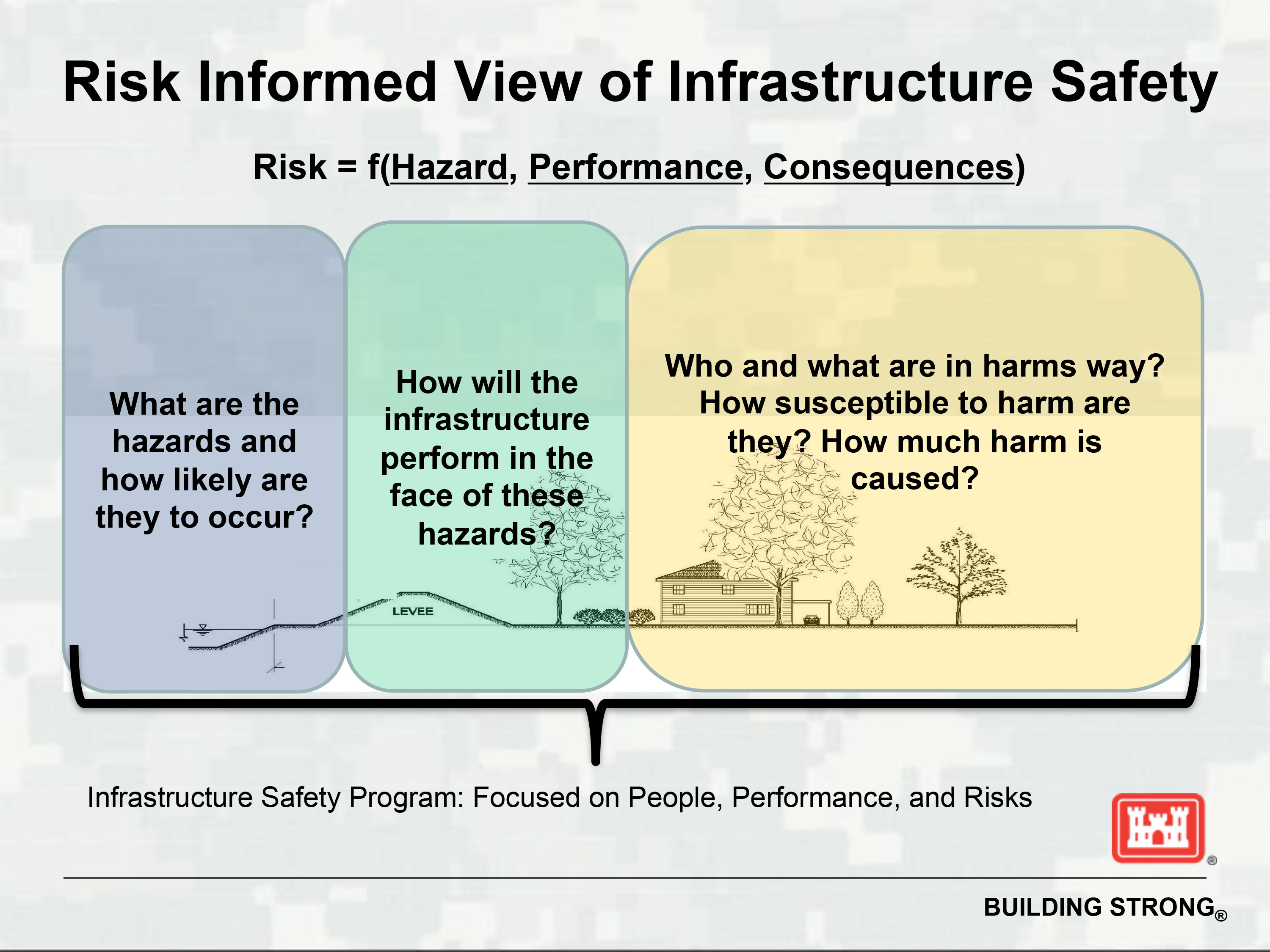Flood Risk General Information
Flood risk is a combination of how well a levee can be expected to keep water from flooding the protected area and the consequences that would occur if the water did flow into that area. When the greatest risks to levee performance are identified, the repairs needed can be prioritized to provide the biggest benefit. Also, understanding and communicating what will happen should the levee fail is important from a land use planning perspective and emergency response planning perspective.
Why Assess Risk?
It is important to know how levees are expected to perform and what the potential consequences of non-performance would be – in other words, to place levee systems in a risk-informed context. The essential questions are:
- What possible loading events (flood, storm, earthquake, etc.) could occur?
- How will the levee perform when subjected to these events?
- What are the consequences of the levee doesn’t perform well – in particular, what loss of life could occur?
Putting levees in a risk context is a consistent and credible way to prioritize actions in a time of constrained resources. USACE plans to use risk assessments to prioritize life safety risks for its own levee safety activities, and also to provide a basis for communicating risk so levee sponsors and other stakeholders can make more informed decisions.
USACE quantifies flood risk associated with four scenarios:
- Breach prior to overtopping
- Overtopping with breach
- Malfunctions of levee system components
- Overtopping without breach
Risk Reduction, Now What?
When results of a levee inspection or risk assessment are released, levee sponsors, local leaders, and the public will all have one question: “Now. What?” A key priority is to ensure that people living or working in leveed areas get accurate and timely information so they can take action.
USACE can advise decision-makers, but many challenges will be solved by the local community. The levee sponsor is responsible for operation, maintenance, repair, replacement, and rehabilitation of the levee system, and has the lead role in planning the way forward. USACE can provide advisory help, technical assistance, or cost-shared construction. Government agencies at every level, as well as the private sector and the public, also have roles to play.
Overall, USACE can support risk reduction activities not only through the Levee Safety Program, but also through the Flood Risk Management Plan, Silver Jackets Program, and authorities such as Floodplain Management Services, Planning Assistance to States, Advance Measures, and others.
Interim Risk Reduction
Interim risk Reduction Measures (IRRMs) are effective, interim actions taken to reduce flood risks while longer term solutions are planned and implemented. IRRMs are a critical part of responsible, adaptive flood risk management. Even levee systems that may not pose high risks can benefit from IRRMs.
USACE will develop and implement Interim Risk Reduction Measures Plans for levees USACE operates and maintains. For other levees, USACE can assist I an advisory role.
Long Term Risk Reduction
Levee safety is just one component of a comprehensive flood risk management approach. Beyond repair, rehabilitation or replacement of levees, local leaders will want to consider such factors as land use planning, development decisions, zoning, building codes, emergency management, and evacuation plans, flood proofing of structures, and ring levee construction.
Addressing System-Wide Deficiencies
USACE established the System-wide Improvement Framework process to provide eligible levee sponsors an extended period of time to address deficiencies such as erosion, seepage, or vegetation which more require a multi-year effort and coordination among multiple entities. The process supports prioritizing deficiencies so that the highest risk issues are addressed first. This joint approach to developing solutions ensures that local and regional resources come together to address site-specific conditions.
In addition, USACE can support levee sponsors with long-term risk reduction solutions through existing processes, including Section 408, 205, and 216 of its authorizing legislation.
What Can You Do?
If you live or work in a community with levees, there is a role for you. First, know your risk. No matter how strong of well maintained a levee is, there is always risk. Second, take action to reduce your risk. Have an evacuation plan. You should pay attention to flood watches and warnings and purchase flood insurance, whether it is required or not. And support your community’s effort to reduce the risk.
